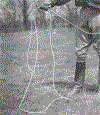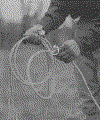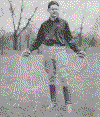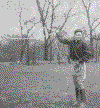By BERNARD S. MASON

2. The Noose on the Catch Rope
Ready to be Thrown
We are now ready to rope. Holding on to the honda, throw the rope out on the ground and shake the kinks and twists out of it. Now shake out a noose in the right hand as in Picture 2. The noose should be roughly four or five feet long, the exact length as it hangs making very little difference, and the honda should hang about half way down or a little more. Be sure the honda is on the outside-the side away from you. That is important. Now with the noose all arranged, coil up the lariat with the left hand, taking the coils in the right hand. Each coil should be about 15 or 18 inches long When the coiling is completed, transfer the coils to the left hand, as in Picture 4, taking the end between the thumb and finger. This coiling should be carefully done so that the rope will run out smoothly from the hand when it is thrown.

3. Coiling-Give the Rope a
Half Turn With Your Fingers
Each Time You Lay a Coil in
To be able to coil a lariat neatly and quickly is an accomplishment in itself and there is a little trick to it which can he easily picked up. As you hold the noose in your right hand as in Picture 2 and bring the coils around with your left hand, give the rope a half turn toward you with your fingers each time as you lay it in your hand, as indicated in Picture 3. This makes the coils lie flat in your hand and prevents the kinking which is so annoying.

4. Hold the Coils
in the Left Hand.
For the position you are in just before throwing, study Picture 5 carefully. Standing in this position, swing the noose up and around overhead as in Picture 6. This is your wind-up. You do it for much the same reason that a pitcher winds up in baseball-it gives you steadiness and helps your aim. Furthermore, it opens the noose for the throw. This swinging is done with a right to left motion that is, as the noose passes in front of you it is moving from your right to left. As you swing it in the air you can let out more rope and thus enlarge the noose until it feels in your hand to be about the right size for the throw. Just how big the noose should be depends upon the object at which you are throwing-one has to learn to judge this from experience. Two or three swings should be sufficient.

5. Ready to Throw.
Let us suppose that we are roping a post in the back yard having wound up, step straight toward the post and throw. Keep your eye on the top of the post and throw straight at it. Do not throw in the general direction of the post and trust to luck that the noose will hit it: Put it there. Just as in baseball some players fail to bat consistently because they take their eyes from the ball a fraction of a second before the bat connects, or would have connected, so in lariat throwing you must keep your eye on the target constantly, from the time you start the wind-up until the noose hits or misses. You may do nothing more than wrap the rope around yourself the first time, but never mind that. Stay with it.

6. The Wind-Up Swing.
At the start it is best to stand not more than ten feet away from the post. Gradually you can work back to thirty feet, which is a good distance to test one's skill. It is the usual maximum distance for roping, although Texas cowboys sometimes succeed in making catches at forty or even fifty feet.

7. Step Forward and
Throw Straight At It.
If these instructions are being followed, all you will have to do is to keep working. It will come to you before you know it. There is only one secret in roping, and that is work. To become a good roper you must practice, practice, practice. For my part, I never admit to myself that I can do anything of this sort until I can do it fifty times in succession on several successive days. Keep score on yourself as you practice: How many times out of twenty-five can you rope the post? Then how many out of fifty? Do not stop today until you have beaten yesterday's record.
You may have trouble at times in getting the loop to open for you as you swing it in the air. This is due to the fact that the rope is twisted. When such is the case there is no use trying to throw, nor is there any use putting your foot on the noose and trying to stretch the kinks out of it as amateurs are wont to do. Slide the honda down to the end, and, taking it in your hand, unwind and shake the twists out. Then re-coil and the noose will stay open. It takes time and is annoying, but there is no other solution.
THE STRAIGHT THROW OR TOSS

8. Arrangement for the
Toss or Straight Throw.
Another method of lariat throwing is the toss or straight throw, which is a cast without a wind-up, and is really much more useful and convenient than the wind-up method; in fact, in the actual roping of animals it is indispensable. Experienced ropers seldom use the wind-up except on horseback. To walk into a corral of horses swinging a noose around one's head preparatory to throwing would be the height of folly; it would work the horses up into a frenzy and make it exceedingly difficult to single out the one desired. Instead the rope must be thrown from the ground without any preliminary swinging. The wind-up is the usual method on horseback, but is seldom used on the ground.
Arrange the rope as for the wind-up throw, and stand as in Picture 8. Note that the palm of the hand holding the noose is up and that the noose is well to the rear. From this position step toward the post with the left foot and throw the noose over and down on it without any preliminary winging. At the start it is better to stand about six feet from the target and toss the noose over on it until the wrist develops the right motion. With a little practice this method becomes much easier and more fascinating than the wind-up.
THE LEFT TO RIGHT THROW
Roping an animal around the neck with either the wind-up throw or the toss is a simple task, provided he is facing you or headed toward your right. If he is headed toward the left, however, the task is much more difficult and requires the left to right throw.
Arrange the rope as before, holding the noose in your right hand, but wind up by swinging it from left to right that is, as the noose passes in front of your body, it is moving from left to right. Cast so that the noose approaches the target from the left.